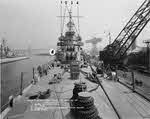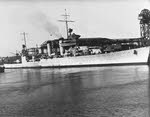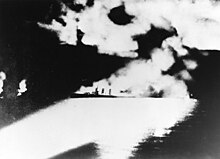
|
USS Quincy (CA-39) was a New Orleans class heavy cruiser that served with the Neutrality Patrol in the Atlantic and fought at Guadalcanal, before being sunk during the battle of Savo Island of 9 August 1942. Quincy earned one battle star during World War II.
The previous pair of ships, Tuscaloosa (CA-37) and San Francisco (CA-38) had been given a lighter 8in gun and a smaller turret, saving around 40 tons. This weight was used to increase the amount of barbette armour, but this turned out to bring them very close to the treaty limits. In order to counter this Quincy and Vincennes had some armour removed, especially in the barbettes.

USS Quincy (CA-39) at
New York, 29 May 1942
San Francisco (CA-38), Quincy (CA-39) and Vincennes (CA-44) were the first US cruisers to be fitted with emergency diesel generators.
The Quincy was laid down in November 1933, launched in June 1935 and commissioned on 9 June 1936. She joined Cruiser Division 8 of the Atlantic Fleet. Her first operational duty came a few weeks later, when on 20 July she was ordered to join the American naval force protecting US interests during the Spanish Civil War. She reached Malaga on 27 July and formed part of an international fleet that included the German ships Deutschland, Admiral Graf Spee and Admiral Scheer. During her time in Spain she transported 490 refugees to Marseilles and Villefranche, but she was replaced by the Raleigh on 27 September.
Her first deployment had been so rushed that she hadn’t yet undergone acceptance trials. These took place in March 1937, and she was then allocated to Cruiser Division 7, based at Pearl Harbor, where she arrived on 10 May. She was just in time to take part in a Pacific Fleet tactical exercise. In 1938 she took part in Fleet Problem XIX, off Hawaii. She was then overhauled at Mare Island Navy Yard, before at the start of January 1939 she was ordered to join the Atlantic Fleet. She arrived in time to take part in Fleet Problem XX in February 1939. In April-June she made a goodwill tour of South American then in July-August she carried out three training cruises for reservists.
Wartime Service
After the outbreak of the Second World War the Quincy took part in the Neutrality Patrol in the North Atlantic. In the spring of 1940 she was overhauled again, then took part in a lengthy tour of Brazil, Uruguay and Argentina that lasted until September. She then carried out three more training cruises in October-December 1940.

USS Quincy (CA-39) moored
In early 1941 Quincy took part in Atlantic Fleet manoeuvres. In April-June she was with Task Group 2 (USS Wasp), in the mid-Atlantic and from June-July she served alongside the Yorktown. In late July she was part of Task Group 16, the naval force that helped take over the protection of Iceland. She carried out a patrol in the Denmark Straits (21-24 September), then in late October sailed for Newfoundland, protecting a convoy. She then moved to Cape Town and escorted a convoy back to Trinidad, arriving on 29 December 1941. She was back at Iceland in January-March 1942, before returning to New York for an overhaul that lasted from March to May 1942.
After this overhaul the Quincy was sent to the Pacific, reaching San Diego on 19 June 1942. She became the flagship of Rear Admiral Norman R. Scott, Commander Cruisers, and part of Task Force 18. This force was allocated to the invasion of Guadalcanal. The Quincy took part in a pre-invasion bombardment of Lunga Point, then supported the Marine landings on 7 August.
The Japanese responded in force, sending a surface fleet to attack the American shipping. This fleet caught the Americans by surprise early on 9 August (battle of Savo Island). Three of the New Orleans class ships, Quincy, Astoria and Vincennes, formed the Northern Escort Force off Guadalcanal. They were attacked by the Japanese just before 2am on 9 August. Vincennes was first to be hit, and was soon dead on the water. Quincy was second in line, and was hit by heavy Japanese gun fire. All of her guns were knocked out and a few minutes after coming under attack she was on fire. Finally the Astoria was hit by the fifth Japanese salvo aimed at her and was out of control by the time the Japanese withdrew. All three of the damaged cruisers sank. Quncy was hit by at least 54 shells and three torpedoes and suffered the loss of 370 of her crew.
Wartime Modification
All members of the New Orleans class received quad 1.1in gun mounts early in 1942, with two on the quarterdeck and two at the same level as the chart house. They also got search radar and had the foremast reduced in height. Quincy was also give twelve single 20mm guns.
Loss at the Battle of Savo Island
While on patrol in the channel between Florida Island and Savo Island, in the early hours of 9 August, Quincy was attacked by a large Japanese naval force during the Battle of Savo Island

Quincy caught in Japanese searchlights, moments before sinking off Savo Island with great loss of life, on 9 August 1942
Quincy, along with sister ships USS Astoria (CA-34) and USS Vincennes (CA-44), had seen aircraft flares dropped over other ships in the task force, and had just sounded general quarters and was coming alert when the searchlights from the Japanese column came on. Quincy’s captain, Samuel N. Moore, gave the order to commence firing, but the gun crews were not ready. Within a few minutes, Quincy was caught in a crossfire between Aoba, Furutaka, and Tenryū, and was hit heavily and set afire. Quincy’s captain ordered his cruiser to charge towards the eastern Japanese column, but as she turned to do so Quincy was hit by two torpedoes from Tenryū, causing severe damage. Quincy managed to fire a few main gun salvos, one of which hit Chōkai’s chart room 6 meters (20 ft) from Admiral Mikawa and killed or wounded 36 men, although Mikawa was not injured. At 02:10, incoming shells killed or wounded almost all of Quincy’s bridge crew, including the captain. At 02:16, the cruiser was hit by a torpedo from Aoba, and the ship's remaining guns were silenced. Quincy’s assistant gunnery officer, sent to the bridge to ask for instructions, reported on what he found:
"When I reached the bridge level, I found it a shambles of dead bodies with only three or four people still standing. In the Pilot House itself the only person standing was the signalman at the wheel who was vainly endeavoring to check the ship's swing to starboard to bring her to port. On questioning him I found out that the Captain, who at that time was laying near the wheel, had instructed him to beach the ship and he was trying to head for Savo Island, distant some four miles (6 km) on the port quarter. I stepped to the port side of the Pilot House, and looked out to find the island and noted that the ship was heeling rapidly to port, sinking by the bow. At that instant the Captain straightened up and fell back, apparently dead, without having uttered any sound other than a moan."
Quincy sustained many direct hits which left 370 men dead and 167 wounded. She sank, bow first, at 02:38, being the first ship sunk in the area which was later known as Ironbottom Sound.
Rediscovery
Quincy's wreck was discovered and explored by Robert Ballard and his crew in July and August of 1992. Quincy sits upright in roughly 2,000 feet (610 m) of water. Her bow is missing forward of her number 1 turret, both forward turrets are trained to starboard, with turret 1 featuring a jammed gun, and one of turret 2's guns burst. Of the superstructure, the bridge is heavily damaged but intact, both funnels are missing, and the float plane hangar completely collapsed. Quincy's stern is bent upwards aft of the number 3 turret, and heavily damaged by implosions.
|
Displacement (standard)
|
10,136t
|
|
Displacement (loaded)
|
12,463t
|
|
Top Speed
|
32.7kts
|
|
Range
|
10,000nm at 15kts
|
|
Armour – belt
|
5in to 3.25in over 0.75in STS
|
|
- over machinery
|
2.25in
|
|
- magazines
|
4in-3in side
2.25in above
|
|
- barbettes
|
6in-5in
|
|
- turrets
|
6in face
2.25in roof
1.5in side
|
|
Length
|
588ft oa
|
|
Armaments
|
Nine 8in/55 guns (three 3-gun turrets)
Eight 5in/25 guns (eight single positions)
Eight 0.5in guns (eight single positions)
Four aircraft
|
|
Crew complement
|
868
|
|
Laid Down
|
15 November 1933
|
|
Launched
|
19 June 1935
|
|
Completed
|
9 June 1936
|
|
Lost
|
9 August 1942
|
|



